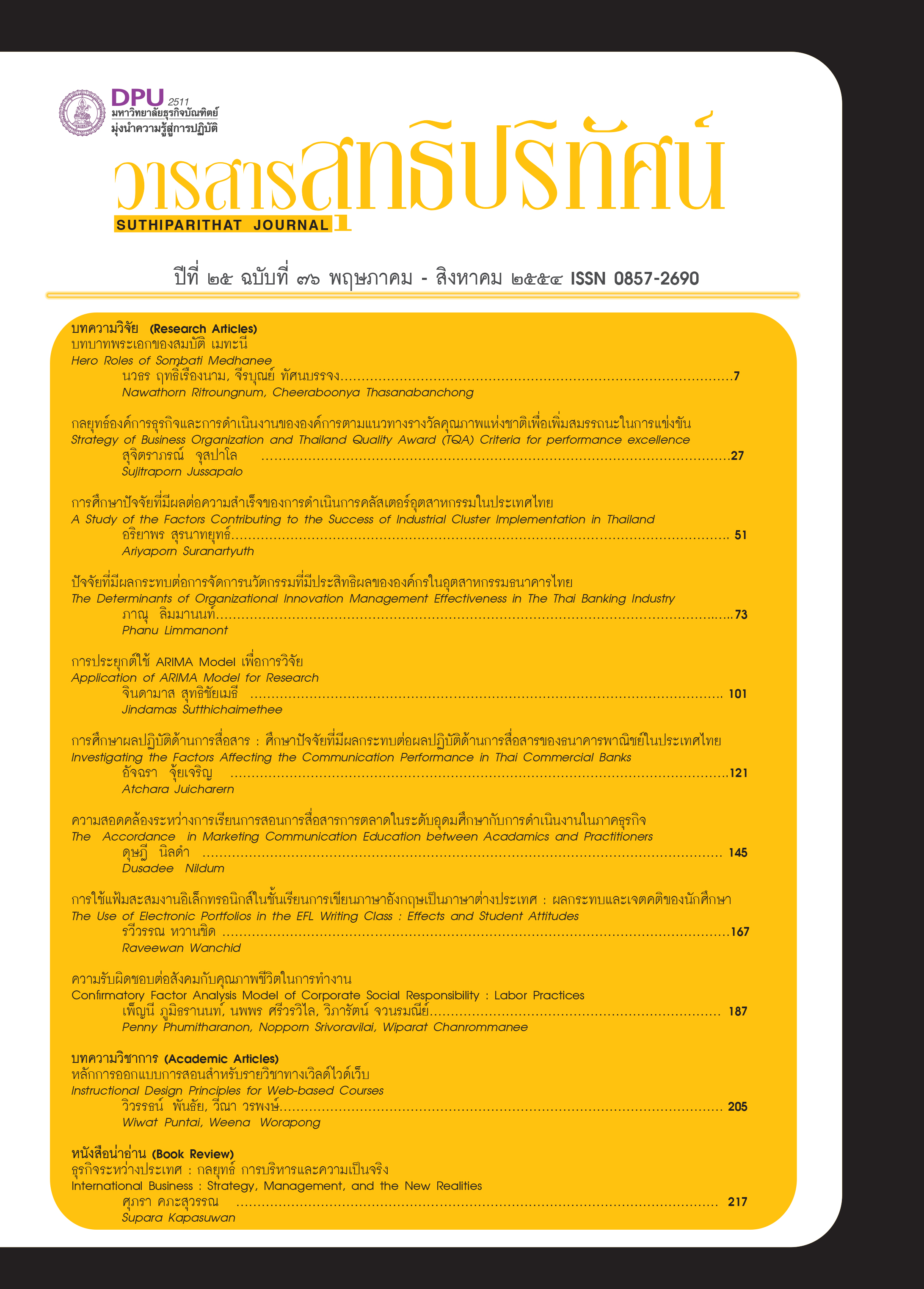การศึกษาปัจจัยที่มีผลต่อความสำเร็จของการดำเนินการคลัสเตอร์อุตสาหกรรมในประเทศไทย
คำสำคัญ:
คลัสเตอร์, ความสำเร็จในการดำเนินนโยบาย, ประสิทธิผล, ประสิทธิภาพ, การมีส่วนร่วมของผู้มีส่วนเกี่ยวข้อง, ความสามารถในการบริหารจัดการ, การสนับสนุน, ความชัดเจนของวัตถุประสงค์, ความสามารถของสมาชิกคลัสเตอร์และเจ้าหน้าที่ภาครัฐที่ดำเนินการ, การสื่อสาร, คุณภาพของโครงการบทคัดย่อ
บทความนี้ได้ทบทวนวรรณกรรมเพื่อพัฒนาแนวความคิดการหาปัจจัยสู่ความสำเร็จ ในการพัฒนาคลัสเตอร์อุตสาหกรรมของไทยให้มีประสิทธิภาพและเป็นพื้นฐานในการเพิ่มขีดความสามารถทางการแข่งขันของประเทศ โดยแนวคิดการพัฒนาคลัสเตอร์อุตสาหกรรมถูกริเริ่มจากการที่เศรษฐกิจของไทยรวมถึงนานาประเทศทั้งประเทศที่ถูกจัดอยู่ในกลุ่มประเทศ ที่เจริญแล้วและกลุ่มประเทศที่กำลังพัฒนาประสบปัญหาอย่างรุนแรงเนื่องจากการเจริญเติบโตอย่างรวดเร็วของเศรษฐกิจสาธารณรัฐประชาชนจีน ราคาสินค้าต่อหน่วยของจีนมีราคาค่อนข้างต่ำเมื่อเทียบกับราคาสินค้าของนานาประเทศ ทำให้สินค้าไทยมีความสามารถในการแข่งขันทางด้านราคาน้อยลง ด้วยเหตุนี้ รัฐบาลไทยโดยสำนักงานคณะกรรมการพัฒนาเศรษฐกิจและสังคมแห่งชาติ (สศช.) จึงมีแนวความคิดในการบรรจุยุทธศาสตร์การยกระดับขีดความสามารถทางการแข่งขันของประเทศไทยเป็นวาระแห่งชาติ โดยได้นำแนวคิดการพัฒนาคลัสเตอร์ที่ริเริ่มโดย ศาสตราจารย์ Michael E. Porter ผู้มีชื่อเสียงมาประยุกต์ใช้เป็นเครื่องมือในการยกขีดความสามารถทางการแข่งขันของประเทศ ซึ่งแนวคิดการพัฒนาคลัสเตอร์ได้ถูกจัดเป็นหนึ่งในยุทธศาสตร์หลักของการพัฒนาประเทศ ทั้งนี้กรมส่งเสริมอุตสาหกรรม (กสอ.) กระทรวงอุตสาหกรรม ได้รับมอบหมายให้เป็นหน่วยงานหลักในการดำเนินงานพัฒนาคลัสเตอร์อุตสาหกรรม (Industrial Cluster) โดยปีงบประมาณ 2549 เป็นปีแรกที่ กสอ. ได้มีการโครงการพัฒนาคลัสเตอร์อุตสาหกรรม โดยผลจากการวิเคราะห์ปัจจัยสู่ความสำเร็จของการดำเนินงาน โครงการพัฒนาคลัสเตอร์อุตสาหกรรมในประเทศไทยประกอบด้วย (1) การสนับสนุนจากภาค รัฐ (2) ความชัดเจนของวัตถุประสงค์ (3) ความสามารถของสมาชิกคลัสเตอร์และเจ้าหน้าที่ภาครัฐที่ดำเนินการ และ (4) คุณภาพของโครงการ
เอกสารอ้างอิง
Arbuckle, J. J. 1995. AMOS User’ s Guide. Chicago: Small Waters Corporation.
Bardach, E. 1977. The Implementation Game: What Happen after a Bill Becomes a Law. Cambridge and London: The MIT Press.
Bollen, K. A. 1989. Structure Equations with Latent Variables. New York: John Wiley & Sons.
Brown, M. W. and Cudeek, R. 1993. Alliterative Ways of Assessing Model Fit, in Texting Structural Equation Model. New Jersey: Sage.
Chandarasorn, Voradej. 1984. Policy Deployment: Model and Value. Bangkok: National Institute of Development Administration.
Chin, W. W. 1998. Issues and Opinion on Structural Equation Modeling. MIS Quarterly. 22 (1): 1-3.
Coakes, S. J. and Steel, L. G. 2001. SPSS: Analysis Without Anguish Version 11.0 for Windows. Brisbane, Australia: John Wiley & Sons.
Cronbach, J. 1990. Essential of Psychology Testing. New York: Hanpercollishes.
Edward, Corwin. 1980. Big Business and the Policy of Competition. Westport, Conn.: Greenwod Press.
Elmore, Richard F. 1979. Complexity and Control: What Legislators and Administrators Can Do about Implementation. Public Policy Paper No.11. Institute of Governmental Research, University of Washington.
European Commission. 2006. Reporting Intellectual Capital to Augment Research, Development and Innovation in SMEs. Report to the Commission of the High Level Expert Group on RICARDIS, Luxemburg, COM. Retrieved June 23, 2006 from http://ec.europa.eu/invest-in-research/policy/capital_report_en.htm
Grabher, G. 1993. The Weakness of Strong Ties: The Lock-in of Regional Development in the Ruhr Area. In The Embedded Firm: On the Socioeconomics of Industrial Network. G. Grabher, ed. London: Routledge.
Heidenreich, M.and Krauss, G. 1998. The Baden-Wurttemberg Production and Innovation Regime-between Past Successes and New Challenges. In Regional Innovation Systems. H.J. Braczyk, P Cooke and M Heidenreich, eds. London: UCL-Press.
Jacob, D. and De Man, A. P. 1996. Cluster, Industrial Policy and Firm Strategy. A Menu Approach. Technology Analysis and Strategic Management. 8: 425–437.
Joreskog. K. G. and Sorbom, D. 1993. Lisrel 8: Structural Equation Modeling with the Simplist Command Language. Chicago: Software International.
Ketels, Christian. 2003. The Developments of the Cluster Concept-Present Experiences and Further Development. Paper for the NRW Conference on Clusters in Germany, Harvard Business School, November.
NESDB. 2007. The 10th National Economics and Social Development Board. Retrieved September 23, 2010 from http://www.nesdb.go.th.
NESDB. 2010. Cluster Concept. Retrieved July 8th, 2010 from http://www.nesdb.go.th
Nunnally, J. C. 1978. Psychometric Theory. New York: McGraw-Hill.
OSMEP, 2010. The White Paper on Small and Medium Enterprises of Thailand in 2009 and Trends 2010. Retrieved December 12, 2010 from http://www.osmep.go.th
Patton, M Q. 1979. Evaluation of Program Implementation. Evaluation Studies Reviews Annuals. 4: 318-346.
Porter, M. 1990. The Competitive Advantage of Nations. London: Macmilla Appendix n.
Porter, M. 1997. How Much Does Industry Matter, Really? Strategic Management Journal. 18 (Summer Special Issue): 15-30.
Porter, M. 1998. Clusters and the New Economics of Competition. Harvard Business Review. (December).
Porter, M. E. and Ketels, C. 2003. UK Competitiveness: Moving to the Next Stage. DTI Economic Paper No.3.
Van Meter, D. and Van Horn, C. 1975. The Policy Implementation Process: A Conceptual Framework. Administration & Society Review. (February) 445-487.
ดาวน์โหลด
เผยแพร่แล้ว
รูปแบบการอ้างอิง
ฉบับ
ประเภทบทความ
สัญญาอนุญาต
เนื้อหาและข้อมูลในบทความที่ลงตีพิมพ์ในวารสารสุทธิปริทัศน์ ถือเป็นข้อคิดเห็นและความรับผิดชอบของผู้เขียนบทความโดยตรงซึ่งกองบรรณาธิการวารสาร ไม่จำเป็นต้องเห็นด้วย หรือร่วมรับผิดชอบใด ๆ
บทความ ข้อมูล เนื้อหา รูปภาพ ฯลฯ ที่ได้รับการตีพิมพ์ในวารสารสุทธิปริทัศน์ ถือเป็นลิขสิทธิ์ของวารสารสุทธิปริทัศน์หากบุคคลหรือหน่วยงานใดต้องการนำทั้งหมดหรือส่วนหนึ่งส่วนใดไปเผยแพร่ต่อหรือเพื่อกระทำการใด ๆ จะต้องได้รับอนุญาตเป็นลายลักษณ์อักษรจากวารสารสุทธิปริทัศน์ก่อนเท่านั้น







